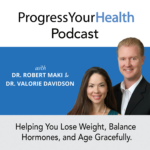

This episode of the Progress Your Health Podcast is a continuation to a recent blog post: 7 Tips on How to Cope with PMS. Most women have some PMS symptoms, but there is certainly a spectrum of symptom severity. For one woman, it might just be mild bloating, but for another woman, her cramps are so bad that she has to miss work due to the pain.
Unfortunately, when you go see your primary care doctor, or even your Gynecologist, the only conventional treatment option is birth control and over the counter Midol. As we discuss in this episode, there a many things you can do to help reduce PMS symptoms.
If you break down the word, Premenstrual Syndrome, it refers to the collection of symptoms that tend to show up prior to menstruation. It is common for PMS symptoms to show up somewhere in the 7 to 10 days before your period. This is time frame usually between ovulation and menstruation.
As you might be aware, PMS symptoms can range from physical symptoms such as cramping and breast tenderness to emotional symptoms such as irritability and anxiety. Over the years, we have seen so many different types of PMS related symptoms. Some symptoms are obvious, but others can be less clear. If you seem to be having recurring symptoms every 2 to 3 weeks, it could easily be related to your cycle.
Below is a list of some of the more common PMS symptoms.
Symptoms of PMS:
Progesterone: Progesterone can be really helpful for PMS but not take non-bioidentical progesterone, progestins. Progestins are just not healthy. But bioidentical micronized progesterone is completely different from the synthetic and can make a huge difference in PMS symptoms. Do not listen to any doctor that tells you otherwise. Because that means they may not be staying up with the latest research (random google posts do not count). But how do you know that your PMS is from low progesterone? Take a progesterone test. Progesterone testing can involve blood, urine, saliva. And all are viable testing for your progesterone levels. Just make sure that you see a doc that knows the interpretation of these tests. Also, (your doc should know this) make sure to do to do your test on day 17 to day 25 (ideally day 21) of your menstrual cycle. Day 21 is when your progesterone should be the highest in your system.
Vitex: Maybe you cannot take progesterone. Maybe you’re not a good candidate for taking progesterone (your experienced doctor will know for sure). Taking vitex (chaste tree berry is the common name) is helpful for low progesterone. It raises LH Lutenizing Hormone, which in turn will raise progesterone.
Evening Primrose Oil (EPO): Women of all ages can take EPO, even as young as teenagers. It helps balance hormones without actually taking hormones. Not to mention EPO is awesome your hair.
Estrogen-Dominance: Estrogen Dominance can cause PMS. Low progesterone can cause Estrogen Dominance. Also high estrogen can obviously cause Estrogen Dominance. To help PMS, we want to reduce estrogen levels. More specifically estrogen metabolites. These are 2OH-estrone and 4OH-estrone. DIM can really help Estrogen Dominance. DIM is derived from indole-3-carbinol. Indole-3-carbinol comes from cruciferous vegetables like broccoli and cabbage.
Liver Function: Your liver detoxes EVERYTHING. But it can also reduce the estrogen metabolites helping Estrogen Dominance. If your liver is not working as well as it could, that can exacerbate if not create PMS symptoms. On a quick side note, if you have elevated liver enzymes, then you have a lowered functioning liver.
Help Your Liver Function Better:
Balance your blood sugar and insulin: High glycemic foods means really high insulin levels. Processed, refined carbohydrates and sugary foods will exacerbate PMS symptoms. That is because they put a burden on your liver and digestion.
Check your thyroid: If your thyroid level is low that can impact your hormones and cause PMS. Lower thyroid levels can directly influence the hormones by exacerbating Estrogen Dominance and reduce progesterone. To accurately test your thyroid make sure to test your TSH, Free T4, and Free T3. For a full explanation here is a link to our podcast.
Body fat, belly fat: Fat tissues, cells secrete hormones believe it or not. In particular, adipose cells (fat cells) secrete estrone (which is an estrogen), creating Estrogen-Dominant.
Reduce Stress: Stress raises cortisol. Cortisol contributes to weight gain, in particular, belly-fat. This excess weight gain can cause more Estrogen Dominance and reduces pregnenolone from your adrenals. Being stressed out can make you fat and have PMS. Also, intense cardiovascular exercise raises cortisol. To reduce cortisol, engage in more weight lifting and walking.
Sleep: Sleep helps PMS. Lack of sleep raises cortisol and insulin. It also inhibits progesterone. For a more in-depth guide to sleep, see our other blog: 11 Tips on How to Improve Sleep with Adrenal Fatigue
Keto Carb Cycling Program: We created a guide to called the Keto-Carb-Cycling-Program, and it’s a free download. Initially, we designed it to help with belly fat, but it also helps reduce PMS symptoms as well. The KCCP is intended to help reduce insulin and balance cortisol. This allows your body to lose weight and as a bonus, your PMS symptoms will also improve.
The post How to Reduce PMS Symptoms Naturally? | PYHP 046 appeared first on .
Discover the common and unfamiliar symptoms that you might be experiencing. Get access to cases of real women with hormonal conditions.

In this episode, we talk about hormone treatments for perimenopause and menopause. There is a vast distinction between perimenopause and menopause when it comes to treatment options. We often see women who are being treated for menopause when they are genuinely not in menopause. Meet Linda: Linda is a listener who sent us a question […]
Recently, Catherine posted a question on our website about Biest cream, and we knew this could interest our listeners. Biest is a combination of estriol and estradiol, one of the most common forms of estrogen therapy used in bio-identical hormone replacement. There are many doses, ratios, options, and methods of using Biest, so we thought […]
Welcome to the Progress Your Health Podcast! This is a podcast that helps you learn about balancing hormones, especially during perimenopause and menopause. We love hearing from our listeners. If you have a question, please visit our website and click Ask the Doctor a question. Let’s read Brigitte’s question! I have been listening and learning […]
In this episode, we talk about the difference between perimenopause and menopause. Both Dr. Maki and I (Dr. Davidson) have worked with women in perimenopause and menopause since 2004 and sometimes get a bit myopic and technical when it comes to explaining the differences. The other day, a patient of Dr Maki’s asked the question, […]
We recently got a great question from a listener and want to share it with you. This question is about a perimenopausal 51-year-old female. She is still menstruating and having confusion about her hormone testing and the hormone therapy that she is currently taking. She is experiencing some breast tenderness and irritability related to her […]
in this episode, we answered a listener’s question. We love questions from listeners. If you have a question, please visit our website and click Ask the Doctor a question. Here is the listener’s question: I have been perimenopause for at least 4 years now I am 47 and after completing a Dutch test with a […]